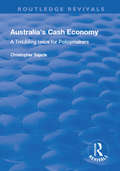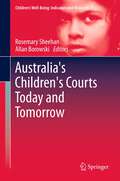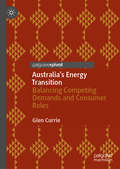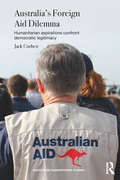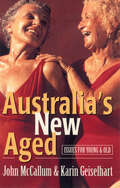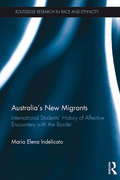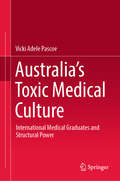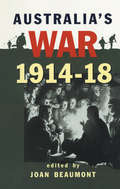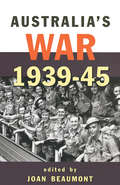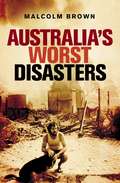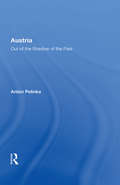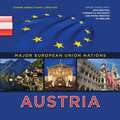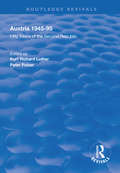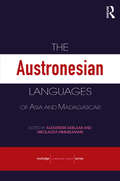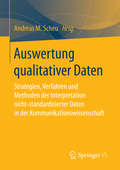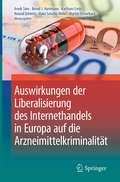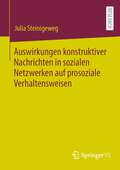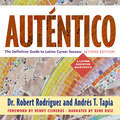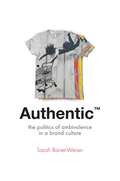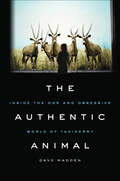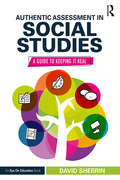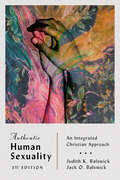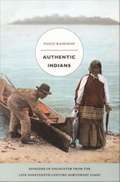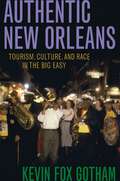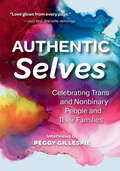- Table View
- List View
Australia's Cash Economy: A Troubling Issue for Policymakers (Routledge Revivals)
by Christopher BajadaThis title was first published in 2002: Very little is known on the Australian underground economy. Only speculation has offered estimates of its size - around ten per cent of GDP. This book provides comprehensive research on the topic for Australia, including the suggestion that the underground economy exhibits strong fluctuations. The text has three central objectives: to understand why a suspiciously large amount of currency remains outstanding and cannot be explained by legitimate transactions alone. Secondly, to examine factors that motivate individuals to participate in the underground economy and the consequences they may have on the business cycle, on the quality of the National Accounts and on taxation revenue. And finally, to examine whether households or businesses are contributing most to the underground economy and whether the new tax system, introduced in July 2000, will have any impact on underground activities in Australia.
Australia's Children's Courts Today and Tomorrow (Children’s Well-Being: Indicators and Research #7)
by Rosemary Sheehan Allan BorowskiThe Children's Court is one of society's most important social institutions. At the same time, it is steeped in controversy. This is in large measure due to the persistence and complexity of the problems with which it deals, namely, juvenile crime and child abuse and neglect. Despite the importance of the Children's Court as a means of holding young people accountable for their anti-social behaviour and parents for the care of their children, it has not been the subject of close study. Certainly it has not been previously studied nationally. This book, an edited collection, is based on the findings of study that spanned the six States and two Territories of Australia. The study sought to examine the current challenges faced by the Children's Court and to identify desirable and feasible directions for reform in each State and Territory. A further unique feature of this study is that it canvassed the views of judges and magistrates who preside over this court.
Australia’s Energy Transition: Balancing Competing Demands and Consumer Roles
by Glen CurrieThis book studies Australia, a country characterized by the highest concentration of domestic photovoltaic systems. In addition, the high level of solar energy that Australia receives makes these systems a significant part of its energy mix. International electricity system managers take note; your systems are heading this way. The energy transition is an emerging field, and few texts have been published that can help energy planners as this book does. The research presented is sociotechnical in nature, and reveals that the main challenge in the energy transition is its emerging social role. Very few works combine the social and technical fields of energy. Given its scope, the book will appeal to readers interested in policy, regulation, and energy systems, including government employees involved in energy system management all around the world.
Australia's Foreign Aid Dilemma: Humanitarian aspirations confront democratic legitimacy (Routledge Humanitarian Studies)
by Jack CorbettThe Australian aid program faces a fundamental dilemma: how, in the absence of deep popular support, should it generate the political legitimacy required to safeguard its budget and administering institution? Australia’s Foreign Aid Dilemma tells the story of the actors who have grappled with this question over 40 years. It draws on extensive interviews and archival material to uncover how 'court politics' shapes both aid policy and administration. The lesson for scholars and practitioners is that any holistic understanding of the development enterprise must account for the complex relationship between the aid program of individual governments and the domestic political and bureaucratic contexts in which it is embedded. If the way funding is administered shapes development outcomes, then understanding the 'court politics' of aid matters. This comprehensive text will be of considerable interest to scholars and students of politics and foreign policy as well as development professionals in Australia and across the world.
Australia's New Aged: Issues for young and old
by John McCallumThe idea that our society is ageing is a popular source of gloomy predictions for the future. We see today's youth struggling in their mature years to pay for the masses of geriatric baby boomers whose productive years lie far behind.Australia's New Aged shows that this belief is part reality and part myth. While there will be an increase in the proportion of aged people in the next 20 years, this is a temporary phenomenon and it is likely that tomorrow's elderly will quite differently from their parents.Australia's New Aged examines public policy for the aged in the context of an increasingly vocal and active elderly population and cutbacks to health and welfare spending. The authors argue that policy makers have become trapped in a 'social problem' approach to ageing that assumes the elderly are a homogeneous, disadvantaged group with common interests. They examine a range of cases and identify negative consequences of inappropriate assumptions in terms of structural blindness and brutality. They show that this approach is no longer viable and argue that both policy makers and the aged care industry will need to be more sensitive to diversity and more flexible than ever before.Australia's New Aged is essential reading for students, policy makers and anyone working with the aged.John McCallum is Professor of Public Health and Dean of the Faculty of Health at the University of Western Sydney, Macarthur and co-editor of Grey Policy (1990). Karin Geiselhart is a journalist previously employed by the Office for the Status of Women in Canberra.
Australia's New Migrants: International Students’ History of Affective Encounters with the Border (Routledge Research in Race and Ethnicity)
by Maria Elena IndelicatoThis book offers a comprehensive and critical analysis of the tropes employed in the categorization of international students living and studying in Australia. Establishing the position of migrant students as ’subjects of the border’, the author employs various models of emotion in an analysis of the ways in which public debates on migration and education in Australia have problematised international students as an object of national compassion or resentment in relation to other national concerns at the time, such as the country’s place in the Asia-Pacific region, the integrity of its borders and the relative competitiveness of its economy. Applying an innovative methodology, which combines the breadth of a diachronic study with the depth afforded by the close analysis of a diverse range of case studies – including the protests staged by Indian international students against a spate of violent attacks, which led to their labelling as ‘soft targets’ in national discourses – Australia’s New Migrants constitutes an important contribution to our understanding of the ways in which emotions shape national collectives’ orientation towards others. As such, it will appeal to scholars of sociology, cultural studies and education with interests in migration, race and emotion.
Australia’s Toxic Medical Culture: International Medical Graduates and Structural Power
by Vicki Adele PascoeThis book explores dominance in Australia’s medical culture through the positioning of international medical graduates (IMGs). It argues that IMGs are ‘othered’ and ultimately positioned as an underclass, a positioning validated and reinforced by the intersecting inequalities of class, race and nation.It also suggests that the positioning of IMGs is organised through the dimensions of structural power, hegemonic power and interpersonal power, which allow an exploration of power relations between the structures of the health system, the Australian medical profession and the agency of IMGs. The Australian narrative presented to the world espouses a community of social justice and human rights. Instead, an historical lens traces the formation and persistence of difference represented in ethnocentrism, racism and xenophobia from 1788 to the present.The research presented is multidisciplinary in scope. An anti-oppressive theoretical framework enables the voices of lived experience to penetrate throughout and a social justice platform engages the participants and the reader into the interwoven conversations. The data set comprises a focus group, 10 individual interviews with IMGs and a selection of inquiry submissions revealing rich and sometimes shocking evidence to paint a stark picture. Other medical voices join the conversation via media responses to revelations of experiences not only by IMGs but also by Australian-trained doctors. It exposes a toxic culture endemic with bullying and sexual harassment.This book is of interest to practitioners, researchers and administrators in the fields of medical education, human resource management, legal studies, health sciences, social sciences, health services, government departments, universities and hospitals, as well as those tasked with duty of care and the provision of a safe workplace. The voices gifted to this study raise awareness of current issues within medicine in Australia at a very personal level and begin to formulate a policy and practical response to address these disturbing revelations.
Australia's War 1914-18
by Joan BeaumontAustralia's War, 1914-18 explores Australia's involvement in the First World War and the effect this had on the nation' s society. In this very accessible book, Joan Beaumont, Pam Maclean, Marnie Haig-Muir and David Lowe focus on: where Australians fought and why; the tensions and realignments within Australian politics in the period of 1914-18; the stresses of the war on Australian society, especially on women and those whom wartime hysteria cast in the role of the 'enemy' at home; the impact of the war on the country's economy; the role played by Australia in international diplomacy; and finally, the creation and influence of the Anzac legend.Once dominated by the battlefield and official accounts of the war correspondent and official historian, C.E.W. Bean, Australian writing on the war has acquired a new depth and sophistication. Studies of the home front reveal a society riven by divisions without precedent in the nation's history.This single volume will be invaluable to tertiary students and of enormous interest to the reader concerned with the social, political and military history of Australia.
Australia's War 1939-45
by Joan BeaumontThe Second World War was a dominant experience in Australian history. For the first time the country faced the threat of invasion. The economy and society were mobilised to an unprecedented degree, with 550 000 men and women, or one in twelve of a population of over 7 million, serving in the armed forces overseas. Social patterns and family life were disrupted. Politically, the war gave a new legitimacy to the Australian Labor Party which had been confined to the wilderness of the Opposition at the Federal level for most of the inter-war years. The powers of the Federal government increased and a new momentum for social reform was generated at the popular and governmental level. In the international sphere, the war fundamentally shook Australian confidence in the power on which it had relied for generations, Great Britain. It generated a sense of independence in Australian foreign policy and initiated a new, if halting and problematic, realignment towards the United States. In this accessible book Joan Beaumont, Kate Darian-Smith, David Lee, David Lowe, Marnie Haig-Muir, Roy Hay and David Walker consider the range of Australia's experience of this conflict. In a single volume they draw together the many aspects of the war and distil the current state of historical scholarship. Australia's War 1939-45 will be invaluable to tertiary students and of enormous interest to the reader concerned with the social, political and military history of Australia. A companion volume on the First World War is also available.
Australia's Worst Disasters
by Malcolm BrownGraphic accounts of Australia?s worst disasters ? historical as well as events of recent years.From the Ash Wednesday bushfires of 1983 to the implosion of the Royal Canberra Hospital in 1997, and from the shocking Granville railway crash in 1977 to the Sea King helicopter crash of 2005, Australia's history has been punctuated by incidents of disaster and tragedy that have shocked us all. Sometimes warning signs were not read (or were ignored); sometimes human error was to blame. These graphic and compelling accounts by veteran Sydney Morning Herald journalist Malcolm Brown and other award-winning journalists tell us far more than simply what happened - they provide unique insights into the impact of these events on the lives of innocent people. And, interspersed with stories of death and destruction, are heart-warming accounts of courage, grace and just plain good luck.
Austria: Out Of The Shadow Of The Past (Contemporary Austrian Studies #Vol. 13)
by Anton PelinkaThis book compares contemporary Austria with other political systems and with the Austrias that existed in the past. The dynamism of the changes taking place in Austria can be described and analyzed with this double focus of comparison.
Austria (Major European Union Nations)
by Jeanine SannaAustria is a German-speaking country with a long history and rich cultural traditions, from kings and queens to musical composers. It has been a member of the EU since 1995. In today's world, Austria welcomes immigrants and struggles to deal with the financial troubles sweeping through Europe. Discover more about this exciting, modern nation!
Austria, 1945-1995: Fifty Years of the Second Republic (Routledge Revivals)
by Kurt Richard Luther Peter PulzerFirst published in 1998. This is the only up to date English language work which seeks to assess the whole of the post war Austrian experience in the light of the latest research, using a multi-disciplinary approach by historians, political scientists, economists, international relations specialists and literary historians. It is addressed not only to specialists in Austrian affairs, but also to studies and scholars concerned with the evaluation of small democracies, their place in an integrated continent and the shape of post-Communist Central Europe. The formative first few decades of the Second Republic are reassessed in four contributions: analysis of the key actors and events involved in the genesis of post war state; of the activities of Karl Renner’s first coalition government; of how tensions regarding Austrian identity were played out in post-war literature and of the competing domestic and superpower perceptions of Austria’s fledging neutrality.
The Austronesian Languages of Asia and Madagascar (Routledge Language Family Ser. #Vol. 7)
by Alexander Adelaar Nikolaus P. HimmelmannSome 800 Austronesian languages are spoken in the area extending from Madagascar to eastern Indonesia and to the north to Taiwan and the Philippines. They vary greatly in almost every possible respect, including the size and social make-up of the speech communities and their typological profiles. This book is designed to serve as a reference work a
Auswertung qualitativer Daten: Strategien, Verfahren und Methoden der Interpretation nicht-standardisierter Daten in der Kommunikationswissenschaft
by Andreas M. ScheuDer Band bietet einen #65533;berblick #65533;ber qualitative Auswertungsverfahren und -strategien im Fach Kommunikationswissenschaft. Die Beitr#65533;ge besch#65533;ftigen sich mit der Auswertung unterschiedlichen Datenmaterials (z. B. Interviews, Gruppendiskussionen, audiovisuelle Daten), mit forschungspraktischen Herausforderungen in Quer- und L#65533;ngsschnittstudien, mit unterschiedlichen Strategien der Datenauswertung (z. B. Typologien, Cluster, Vergleiche, Diskursanalysen, Netzwerkanalysen) sowie verschiedenen qualitativen Perspektiven; von eher induktiven Auswertungsstrategien #65533;ber deduktive, theoriegeleitete Verfahren bis hin zu teilweise automatisierten Prozessen.
Auswirkungen der Liberalisierung des Internethandels in Europa auf die Arzneimittelkriminalität
by Karlhans Liebl Arndt Sinn Hans Schulte-Nölke Bernd J. Hartmann Roland Schmitz Martin SteinebachDieses Handbuch beleuchtet den Internetversandhandel mit illegalen Arzneimitteln über illegale Online-„Apotheken“, der sich zu einem auffälligen Wachstumsmarkt entwickelt hat. Durch die hohen Gewinnmargen und das niedrige Entdeckungsrisiko ist der Handel mit gefälschten Arzneimitteln mittlerweile weitaus attraktiver geworden als der Handel mit Betäubungsmitteln und bietet Potential als Geschäftsfeld der organisierten Kriminalität.Diesem Szenario entsprechend verfolgt das Handbuch bei der Untersuchung internetgestützter Arzneimittelkriminalität einen ganzheitlichen Ansatz, indem eine empirische Aufarbeitung der Täter- und Tatstrukturen in diesem Kriminalitätsbereich ebenso vorgenommen wird wie die Zeichnung des Lagebildes für die Bundesrepublik Deutschland. Im Hauptteil wird die Rechtslage zur Arzneimittelkriminalität in allen 28 EU-Mitgliedstaaten mit schwerpunktmäßiger Berücksichtigung der Aspekte des materiellen Straf- und Prozessrechts rechtsvergleichend aufbereitet, und es werden die einschlägigen internationalen Vorgaben im Bereich der Arzneimittelkriminalität beleuchtet. Außerdem werden zivil- und öffentlich-rechtliche Interventions- und Präventionsalternativen vorgestellt. Nicht zuletzt wird auch eine für die Ermittlungsarbeit entwickelte technische Lösung zur Verfolgung von Arzneimittelstraftaten im Internet vorgestellt. Einschlägige case-studies und eine Szenarioanalyse zur prognostischen Entwicklung der Arzneimittelkriminalität runden die Darstellung ab.Abschließend werden sowohl der Reformbedarf erhoben als auch konkrete Handlungsempfehlungen ausgesprochen, um Konzepte der Verfolgung internetgestützter Arzneimittelkriminalität in Deutschland und Europa zu verbessern und eine breite Datenbasis für den Gesetzgeber zur effektiveren Gesetzgebung zu schaffen.
Auswirkungen konstruktiver Nachrichten in sozialen Netzwerken auf prosoziale Verhaltensweisen
by Julia SteinigewegDie Digitalisierung führt zu unterschiedlichen Herausforderungen innerhalb des Journalismus. Konstruktive Journalist:innen setzen sich mit der Frage auseinander, welche Funktionen Journalismus im 21. Jahrhundert zu erfüllen hat. Dabei stehen für sie Lösungsorientierung und Perspektivenreichtum im Fokus der Berichterstattung. Zudem ist es ihr Ziel, durch das Berichten gesellschaftlich relevanter Informationen zu einer mündigen Bevölkerung beizutragen. Im Zuge dessen nimmt die Stärkung prosozialer Selbstwirksamkeitserwartungen und Verhaltensintentionen eine zentrale Rolle ein. Obwohl gerade jüngere Generationen zunehmend konstruktive Elemente in der Berichterstattung fordern, versuchen Medienorganisationen durch aufmerksamkeitserregende Schlagzeilen und Dramatisierungen, ihr Publikum in digitalen Sphären an sich zu binden. Dies hat zur Folge, dass Phänomene wie "news fatigue" oder "doomscrolling" an Relevanz gewinnen. Die vorliegende Arbeit untersucht zunächst, wie konstruktive Nachrichten in sozialen Netzwerken aufbereitet werden können, um Rezipient:innen nachhaltig zu erreichen. Weiterhin geht sie der Frage nach, ob das Berichterstattungsmuster tatsächlich Prosozialität bzw. Engagement in der Gesellschaft fördert.
Auténtico: The Definitive Guide to Latino Career Success (A Latino Executive Manifesto)
by Robert Rodriguez Andrés T. TapiaAmerica has an urgent need for Latino and Latina executives. This book identifies a path to uplift and amplify their representation in leadership.Latinos and Latinas will account for a third of our workforce by 2050-yet they make up only 5 percent of senior roles in corporate America.Dr. Robert Rodriguez and Andr√©s T. Tapia call this low percentage of Latino and Latina corporate executives today the ‚Äú5 percent Shame.‚Äù Inspired by Price M. Cobbs's seminal work on the secrets of successful Black leaders, this book seeks to understand the impact on Latinos and Latinas of the external forces of conscious and unconscious biases and of the internal forces of whether to assimilate or double down on their cultural identities in their quest to get ahead. The second edition features a new foreword by Henry Cisneros, former secretary of the Department of Housing and Urban Development, as well as updated statistics and graphs to represent how America's career landscape for Latinos has and has not changed and how to ensure Latinos can rise to their fullest potential.Using insights from in-depth interviews with twenty highly successful boomer Latino and Latina executives and focus groups with dozens of Gen X and millennial leaders, the authors have captured lessons about how these individuals chose their career paths, addressed challenges, and seized opportunities. The discussions are interpreted through the lenses of the authors' different personal experiences as Latino leaders in corporate America and synthesized as a guide for future leaders.
Authentic™: The Politics of Ambivalence in a Brand Culture (Critical Cultural Communication #30)
by Sarah Banet-WeiserA stimulating, smart book on what it means to live in a brand cultureBrands are everywhere. Branding is central to political campaigns and political protest movements; the alchemy of social media and self-branding creates overnight celebrities; the self-proclaimed “greening” of institutions and merchant goods is nearly universal. But while the practice of branding is typically understood as a tool of marketing, a method of attaching social meaning to a commodity as a way to make it more personally resonant with consumers, Sarah Banet-Weiser argues that in the contemporary era, brands are about culture as much as they are about economics. That, in fact, we live in a brand culture.Authentic™ maintains that branding has extended beyond a business model to become both reliant on, and reflective of, our most basic social and cultural relations. Further, these types of brand relationships have become cultural contexts for everyday living, individual identity, and personal relationships—what Banet-Weiser refers to as “brand cultures.” Distinct brand cultures, that at times overlap and compete with each other, are taken up in each chapter: the normalization of a feminized “self-brand” in social media, the brand culture of street art in urban spaces, religious brand cultures such as “New Age Spirituality” and “Prosperity Christianity,”and the culture of green branding and “shopping for change.”In a culture where graffiti artists loan their visions to both subway walls and department stores, buying a cup of “fair-trade” coffee is a political statement, and religion is mass-marketed on t-shirts, Banet-Weiser questions the distinction between what we understand as the “authentic” and branding practices. But brand cultures are also contradictory and potentially rife with unexpected possibilities, leading Authentic™ to articulate a politics of ambivalence, creating a lens through which we can see potential political possibilities within the new consumerism.
The Authentic Animal: Inside the Odd and Obsessive World of Taxidermy
by Dave MaddenWhy would someone want to create or own the mounted skin of a dead animal? That's the question Dave Madden explores in The Authentic Animal. Madden starts his journey with the life story of Carl Akeley, the father of modern taxidermy. Akeley started small by stuffing a canary, but by the end of his life he had created the astonishing Akeley Hall of African Mammals at The American Museum of Natural History. What Akeley strove for and what fascinates Madden is the attempt by the taxidermist to replicate the authentic animal, looking as though it's still alive. To get a first-hand glimpse at this world, Madden travels to the World Taxidermy Championships, the garage workplaces of people who mount freeze-dried pets for bereaved owners, and the classrooms of a taxidermy academy where students stretch deer pelts over foam bases. On his travels, he looks at the many forms taxidermy takes—hunting trophies, museum dioramas, roadside novelties, pet memorials—and considers what taxidermy has to tell us about human-animal relationships. The Authentic Animal is an entertaining and thought-provoking blend of history, biology, and philosophy that will make readers think twice the next time they scoff at a moose head hung lovingly on a wall.
Authentic Assessment in Social Studies: A Guide to Keeping it Real
by David SherrinThis engaging book will show you how to move beyond tests and essay writing to implement authentic assessments in your middle or high school social studies classroom. Award-winning teacher David Sherrin explains the value of authentic assessments and offers practical ways to get started and dive deeper in your own practice. You&’ll be encouraged and inspired by the real-life stories of classroom successes and failures that illustrate the points throughout the book. The chapters cover a range of categories, including different types of written, creative, and civic action assessments. <P><P> The book includes: <li>planning charts and rubrics showing how to use, grade, and give feedback on assessments so they truly aid student learning and progress <li>specific examples, useful tips, and ready-to-go instructions that you can use immediately with your class <li>open-ended assessments encourage scaffolding or adaptation for individual or group work to fit your classroom needs <p><P>You will learn how to personalize instruction and provide students with avenues for creativity and the types of learning experiences they need to be prepared for a complex world.
Authentic Human Sexuality: An Integrated Christian Approach
by Jack O. Balswick Judith K. BalswickSex pervades our culture, going far beyond the confines of the bedroom into the workplace, the church, and the media.Authentic Human Sexuality
Authentic Indians: Episodes of Encounter from the Late-Nineteenth-Century Northwest Coast
by Paige RaibmonIn this innovative history, Paige Raibmon examines the political ramifications of ideas about "real Indians. " Focusing on the Northwest Coast in the late nineteenth century and early twentieth, she describes how government officials, missionaries, anthropologists, reformers, settlers, and tourists developed definitions of Indian authenticity based on such binaries as Indian versus White, traditional versus modern, and uncivilized versus civilized. They recognized as authentic only those expressions of "Indianness" that conformed to their limited definitions and reflected their sense of colonial legitimacy and racial superiority. Raibmon shows that Whites and Aboriginals were collaborators--albeit unequal ones--in the politics of authenticity. Non-Aboriginal people employed definitions of Indian culture that limited Aboriginal claims to resources, land, and sovereignty, while Aboriginals utilized those same definitions to access the social, political, and economic means necessary for their survival under colonialism. Drawing on research in newspapers, magazines, agency and missionary records, memoirs, and diaries, Raibmon combines cultural and labor history. She looks at three historical episodes: the participation of a group of Kwakwaka'wakw from Vancouver in the 1893 World's Columbian Exposition in Chicago; the work of migrant Aboriginal laborers in the hop fields of Puget Sound; and the legal efforts of Tlingit artist Rudolph Walton to have his mixed-race step-children admitted to the white public school in Sitka, Alaska. Together these episodes reveal the consequences of outsiders' attempts to define authentic Aboriginal culture. Raibmon argues that Aboriginal culture is much more than the reproduction of rituals; it also lies in the means by which Aboriginal people generate new and meaningful ways of identifying their place in a changing modern environment.
Authentic New Orleans: Tourism, Culture, and Race in the Big Easy
by Kevin Fox GothamHonorable Mention for the 2008 Robert Park Outstanding Book Award given by the ASA’s Community and Urban Sociology SectionMardi Gras, jazz, voodoo, gumbo, Bourbon Street, the French Quarter—all evoke that place that is unlike any other: New Orleans. In Authentic New Orleans, Kevin Fox Gotham explains how New Orleans became a tourist town, a spectacular locale known as much for its excesses as for its quirky Southern charm.Gotham begins in the aftermath of Hurricane Katrina amid the whirlwind of speculation about the rebuilding of the city and the dread of outsiders wiping New Orleans clean of the grit that made it great. He continues with the origins of Carnival and the Mardi Gras celebration in the nineteenth century, showing how, through careful planning and promotion, the city constructed itself as a major tourist attraction. By examining various image-building campaigns and promotional strategies to disseminate a palatable image of New Orleans on a national scale Gotham ultimately establishes New Orleans as one of the originators of the mass tourism industry—which linked leisure to travel, promoted international expositions, and developed the concept of pleasure travel.Gotham shows how New Orleans was able to become one of the most popular tourist attractions in the United States, especially through the transformation of Mardi Gras into a national, even international, event. All the while Gotham is concerned with showing the difference between tourism from above and tourism from below—that is, how New Orleans’ distinctiveness is both maximized, some might say exploited, to serve the global economy of tourism as well as how local groups and individuals use tourism to preserve and anchor longstanding communal traditions.
Authentic Selves: Celebrating Trans and Nonbinary People and Their Families
by Jeff MillerGroundbreaking in its depictions of joy and community, Authentic Selves celebrates trans and nonbinary people and their families in stunning photographs and their own words. Foreword by transgender activist Jazz Jennings and her mom and fellow activist, Jeanette Jennings.So often trans and nonbinary people’s stories are told only through the lens of their struggles and challenges, including their political battles for legal rights, but trans and nonbinary people live rich and fulfilling lives full of joy and community too. Authentic Selves: Celebrating Trans and Nonbinary People and Their Families is a sweeping compilation of life stories and portraits of trans and nonbinary people, as well as their partners, parents, children, siblings, and chosen family members.The compelling stories in Authentic Selves provide a glimpse into the real lives, both the challenges and the triumphs, of these remarkable people and their families—people like Senator Sarah McBride, disability justice advocate Parker Glick, drag entertainer TAYLOR ALXNDR, September 11th first responder Jozeppi Angelo Morelli, model Lana Patel, youth activist Elliott Bertrand, and so many others—all of whom are working to create a more just, diverse, and compassionate world.Developed in collaboration with PFLAG National and Transgender Legal Defense & Education Fund.
